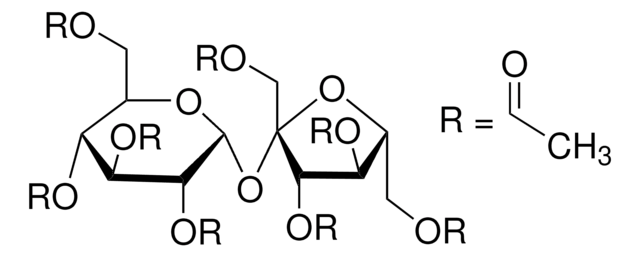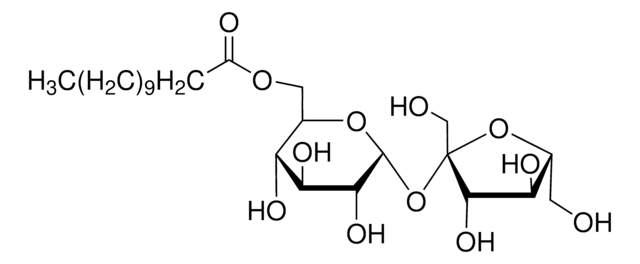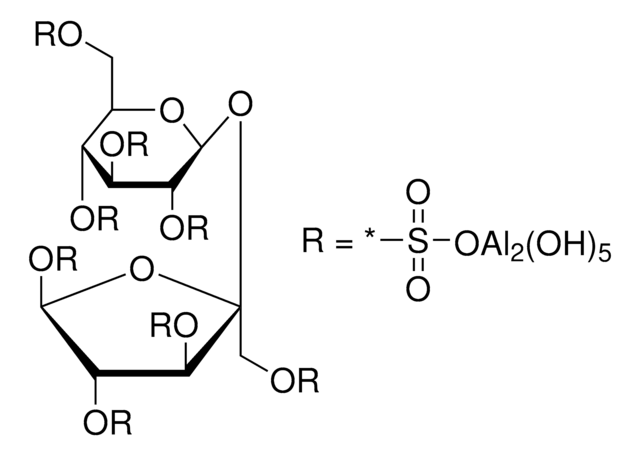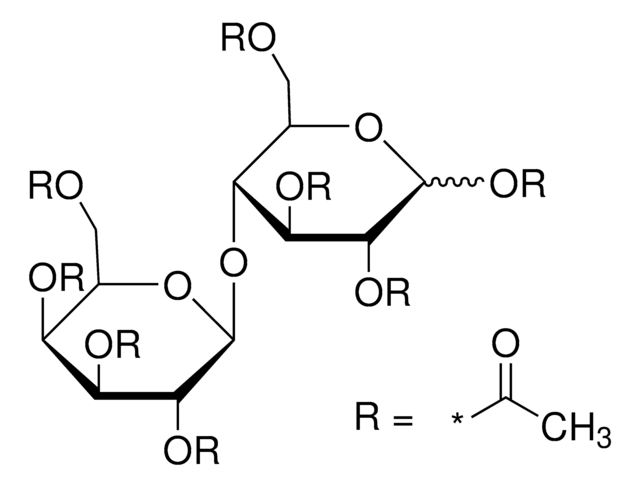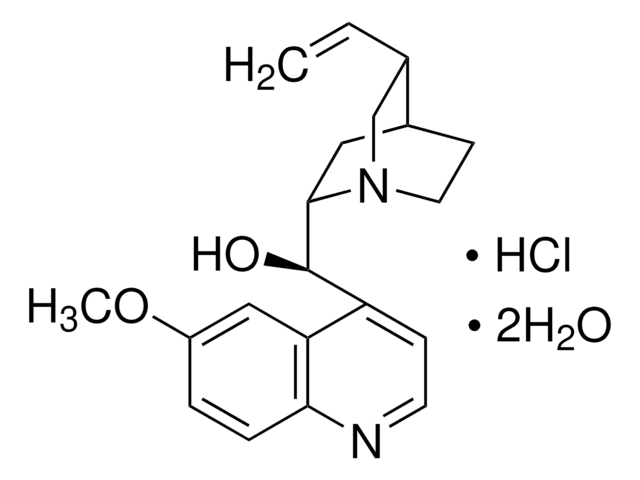Kluczowe dokumenty
W303801
Sucrose octaacetate
≥97%, FG
Synonim(y):
D-(+)-Sucrose octaacetate, Sucrose octaacetate
About This Item
Polecane produkty
pochodzenie biologiczne
synthetic
Poziom jakości
klasa czystości
FG
Halal
Kosher
zgodność regionalna
EU Regulation 1334/2008 & 872/2012
FDA 21 CFR 172.515
FDA 21 CFR 175.105
Próba
≥97%
aktywność optyczna
[α]20/D +59°, c = 2.5 in ethanol
bp
260 °C (lit.)
mp
82-85 °C (lit.)
Zastosowanie
flavors and fragrances
Dokumentacja
see Safety & Documentation for available documents
alergen pokarmowy
no known allergens
Organoleptyczne
odorless
ciąg SMILES
CC(=O)OC[C@H]1O[C@H](O[C@]2(COC(C)=O)O[C@H](COC(C)=O)[C@@H](OC(C)=O)[C@@H]2OC(C)=O)[C@H](OC(C)=O)[C@@H](OC(C)=O)[C@@H]1OC(C)=O
InChI
1S/C28H38O19/c1-12(29)37-9-20-22(40-15(4)32)24(42-17(6)34)25(43-18(7)35)27(45-20)47-28(11-39-14(3)31)26(44-19(8)36)23(41-16(5)33)21(46-28)10-38-13(2)30/h20-27H,9-11H2,1-8H3/t20-,21-,22-,23-,24+,25-,26+,27-,28+/m1/s1
Klucz InChI
ZIJKGAXBCRWEOL-SAXBRCJISA-N
Szukasz podobnych produktów? Odwiedź Przewodnik dotyczący porównywania produktów
Powiązane kategorie
Opis ogólny
Zastosowanie
- High-Degree Concentration Organic Solvent Forward Osmosis for Pharmaceutical Pre-Concentration.: Investigates the potential of organic solvent forward osmosis technologies in pharmaceutical applications, focusing on pre-concentration processes that may benefit from the stabilizing effects of sucrose octaacetate (Takada et al., 2024).
- Nutrient-conditioned intake stimulation does not require a distinctive flavor cue in rats.: Explores behavioral responses in rats to various flavors including sucrose octaacetate, suggesting implications for understanding human dietary choices and the development of food additives (Sclafani et al., 2020).
- Discrimination of Isointense Bitter Stimuli in a Beer Model System.: Examines the ability of individuals to distinguish between different bitter compounds, including sucrose octaacetate, in a controlled beer tasting model, which can influence food science and product development (Higgins and Hayes, 2020).
Kod klasy składowania
11 - Combustible Solids
Klasa zagrożenia wodnego (WGK)
WGK 2
Temperatura zapłonu (°F)
Not applicable
Temperatura zapłonu (°C)
Not applicable
Środki ochrony indywidualnej
Eyeshields, Gloves, type N95 (US)
Wybierz jedną z najnowszych wersji:
Masz już ten produkt?
Dokumenty związane z niedawno zakupionymi produktami zostały zamieszczone w Bibliotece dokumentów.
Klienci oglądali również te produkty
Global Trade Item Number
| SKU | GTIN |
|---|---|
| W303801-25KG | |
| W303801-25KG-K | 4061835566389 |
| W303801-SAMPLE | |
| W303801-SAMPLE-K | 4061834227502 |
| W303801-10KG | |
| W303801-10KG-K | 4061835566365 |
| W303801-1KG | |
| W303801-1KG-K | 4061835566372 |
Nasz zespół naukowców ma doświadczenie we wszystkich obszarach badań, w tym w naukach przyrodniczych, materiałoznawstwie, syntezie chemicznej, chromatografii, analityce i wielu innych dziedzinach.
Skontaktuj się z zespołem ds. pomocy technicznej